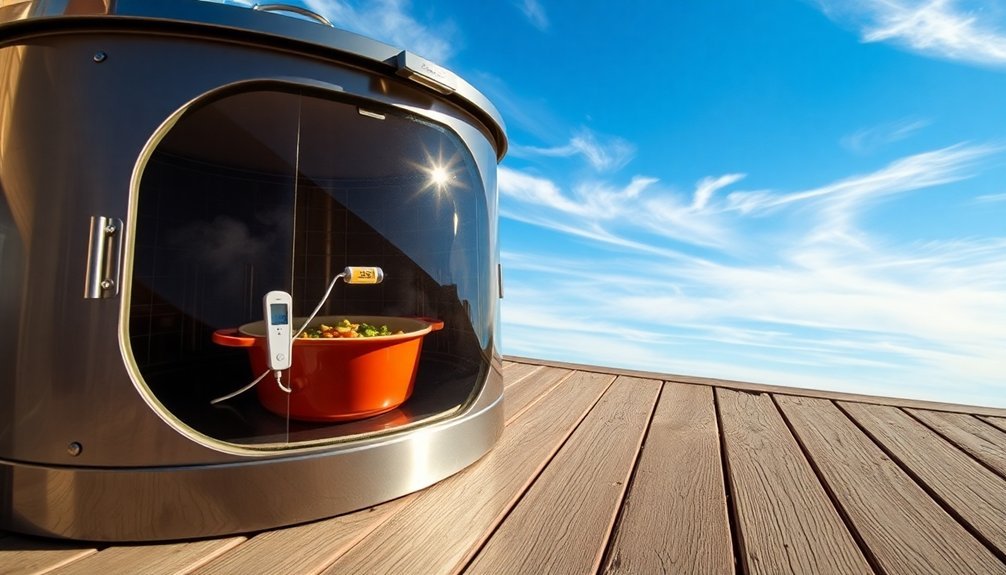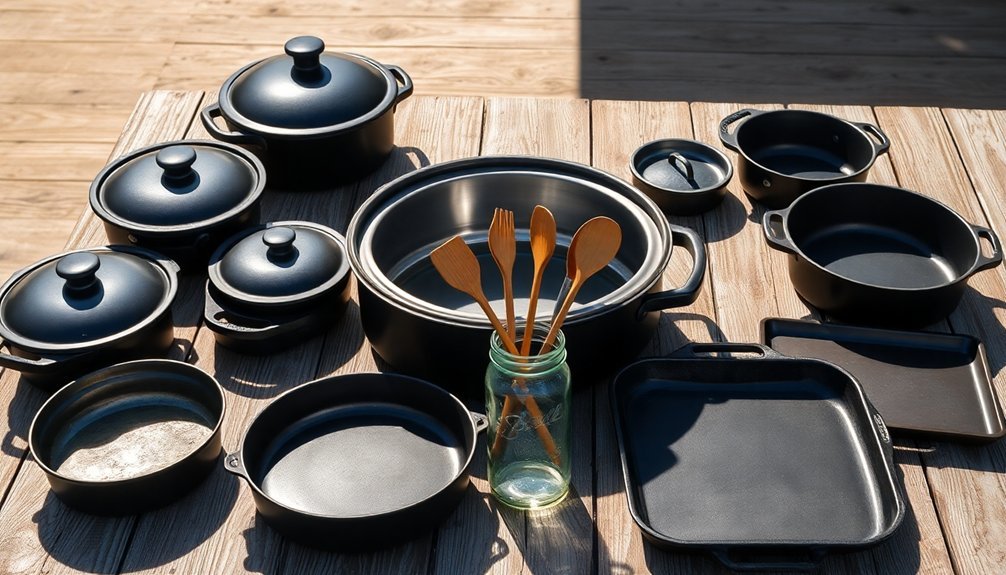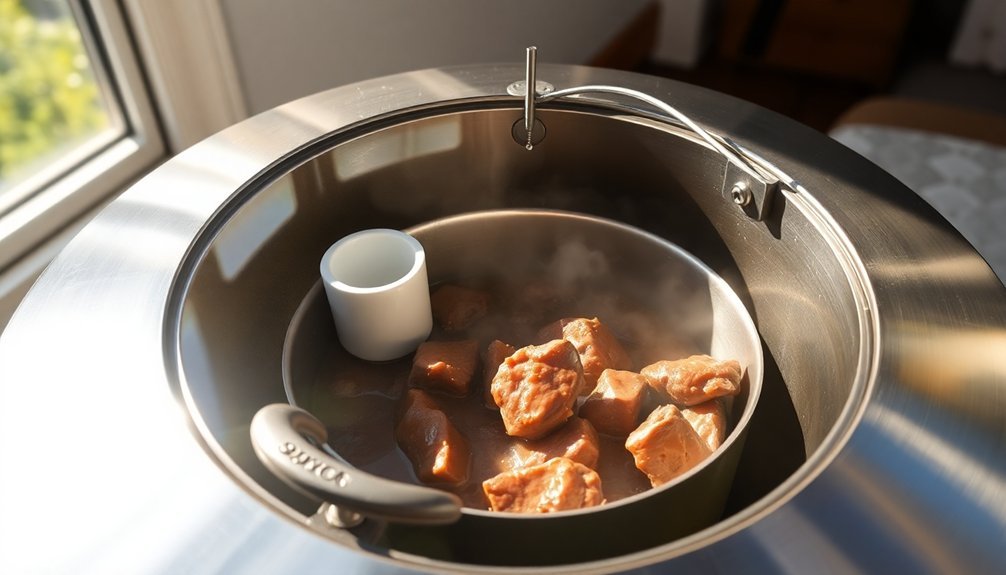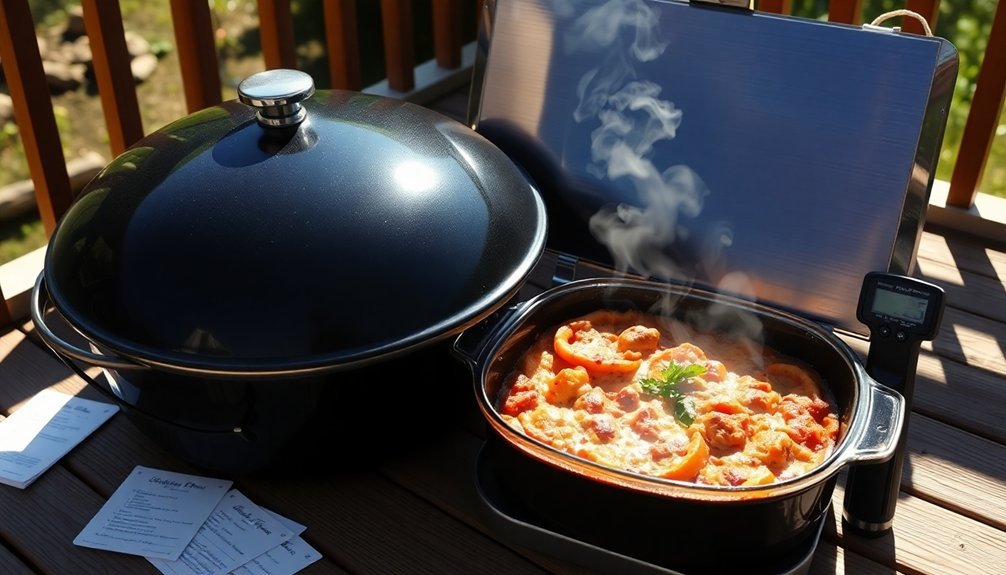To adapt any recipe for your sun oven, start by adjusting cooking temperatures to a minimum of 180°F, with an ideal range of 300-375°F on clear days. You'll need to double cooking times on cloudy days and add 10-15 minutes each time you open the oven door. Use dark-colored, thin-walled cookware for better heat absorption, and reduce liquid content by ¼ to ½ cup since solar cooking retains more moisture. Position your oven in a wind-protected spot and realign it every 30 minutes with the sun. Monitor internal temperatures with an oven thermometer, and consider starting earlier in the day. These fundamental adjustments are just the beginning of your solar cooking success.
Temperature Control Basics

Solar cooking success begins with understanding temperature control in your Sun Oven. You'll need to maintain at least 180°F for effective cooking, though your oven can reach up to 400°F in ideal conditions.
On clear days, you can expect temperatures between 300°F and 375°F if you realign every 30 minutes. Keep the glass door latched during preheating and cooking for optimal heat retention. To maximize your oven's temperature, choose a wind-protected location and use dark-colored cookware to absorb heat efficiently.
The time of day and season will affect your cooking temperatures, so you'll get better results during peak sunlight hours. Your location matters too – if you're closer to the Equator, you'll enjoy longer cooking hours and more intense sunlight.
Remember to clean your glass door regularly and remove any protective film from reflectors for best heat retention.
Modifying Cooking Times
When cooking with a Sun Oven, you'll need to adjust your standard recipe times based on several key factors. While cooking times are similar to conventional ovens on clear, sunny days, cloudy conditions can double your cooking duration. The position of the sun and frequency of refocusing your oven also impact how quickly your food cooks. Most recipes can be cooked at temperatures up to 370°F on optimal sunny days.
To enhance your cooking times, follow these essential steps:
- Start cooking by 9:00 AM for lunch or 1:00 PM for dinner.
- Refocus your oven every 30 minutes to maintain ideal temperature.
- Minimize opening the oven door, as each opening adds 10-15 minutes.
- Position the oven where the sun will be strongest during cooking (10 AM – 2 PM).
For best results, remember that soaked beans cook faster, and defrosting meat completely before cooking is vital.
Container and Pan Selection

Your success with a sun oven starts with selecting dark-colored pans and cookware, which absorb sunlight more effectively than light-colored alternatives.
You'll want to choose thin-walled containers that heat up quickly and distribute temperature evenly throughout your food. Our stackable 3-quart pots are an ideal choice for efficient sun oven cooking.
When considering size, opt for smaller, stackable containers that fit your sun oven's dimensions to maximize cooking space and efficiency.
Dark Pans For Success
Selecting the right cookware plays an essential role in sun oven success, with dark pans being the most effective choice. Dark cookware absorbs light and energy more efficiently than shiny alternatives, helping maintain consistent temperatures even on partly cloudy days. Similar to how black construction paper is used to line solar ovens for heat absorption, dark cookware maximizes the cooking efficiency.
For best results in your sun oven, consider these essential cookware options:
- Enamelware pots – They're highly efficient and heat up quickly.
- Cast iron Dutch ovens – Perfect for long, unattended cooking due to excellent heat retention.
- Dark granite ware – Thin and dark properties make it ideal for rapid heating.
- Mason jars – Great for cooking multiple items at once.
If you're stuck with shiny cookware, don't worry – simply cover it with a dark dish towel to improve heat absorption and prevent light reflection.
Remember that ceramic and cast iron heat slowly but maintain temperature well once hot.
Material Size Considerations
The right container and pan dimensions make a significant difference in sun oven cooking efficiency. You'll need to verify your cooking vessels fit comfortably inside without touching the sides or glass, ideally matching your oven's inner box dimensions.
Choose containers that are proportional to your oven's depth, which typically measures about two-thirds of its top dimension. You'll want enough space to cook multiple dishes simultaneously – perhaps a dish and a pan – while maintaining proper air circulation.
For example, if your sun oven has interior dimensions of 50 cm length by 30 cm width, select cookware that fits within these parameters while leaving some clearance space.
Test your container placement before cooking, and consider creating a full-size side view drawing to determine best sizing for your specific setup.
Ingredient Adjustments For Solar
Making ingredient adjustments for solar cooking requires flexibility and strategic substitutions to achieve ideal results. You'll need to adapt your proteins, vegetables, seasonings, and liquids to work effectively in your sun oven's unique cooking environment.
- Choose proteins wisely – interchange pork tenderloin with shoulder, or opt for alternative proteins like lentils, split peas, or shrimp. Pre-sear meats in a cast iron skillet for enhanced flavor.
- Prep vegetables according to space – use raw, browned, or dehydrated onions, rough-chop tomatillos, and incorporate fresh or powdered garlic based on your needs.
- Adjust seasonings freely – modify cumin, turmeric, and ginger quantities, or swap in posole seasoning for regional flair.
- Monitor liquid levels carefully – add broth or water as needed to maintain moisture and achieve desired consistency during the solar cooking process.
Moisture Management While Cooking

When cooking with your sun oven, you'll want to minimize unnecessary steam release while keeping natural food juices intact.
You can prevent excess moisture by reducing liquid content in recipes and using absorbent materials like dark tea towels under pot lids.
Strategic venting techniques, such as placing a small skewer between the door and gasket, let you control steam without significant heat loss.
Avoid Excess Steam Release
Successful solar cooking requires careful management of moisture and steam to prevent your food from becoming waterlogged or losing heat through excessive venting.
You'll need to balance moisture retention with proper steam release to achieve ideal cooking results.
- Reduce liquids in your recipes by ¼ to ½ cup when adapting them for solar cooking, especially for vegetables, beans, and rice dishes.
- Place a dark-colored tea towel under the pot lid to absorb excess moisture while maintaining appropriate heat levels.
- Open the oven door briefly (2-3 seconds) to release steam buildup, but stand back to avoid burns.
- Create minimal venting by leaving one latch slightly loose or using a small wooden skewer between the glass and oven edge.
Remember to monitor your food's progress and adjust these techniques based on your specific recipe and weather conditions.
Retain Natural Food Juices
The art of retaining natural food juices in solar cooking builds upon proper steam management. You'll want to cook vegetables in their own juices using a covered pan without adding water.
For meats, marinate them beforehand to enhance moisture retention during the cooking process, and place them on a rack in a cast iron pot for even heat distribution.
Use dark-colored cookware, especially black cast iron or dark brown glass dishes, as they absorb and retain heat better than light-colored alternatives.
One-pot meals are ideal for minimizing moisture loss and keeping natural flavors intact. When preparing potatoes, rub them with oil and place them in a covered pot.
Always confirm your lids fit properly, and you can use metal office binder clips to create a tighter seal if needed.
Essential Recipe Conversions
Converting traditional recipes for Sun Oven cooking requires understanding key temperature and timing adjustments.
You'll need to plan for longer cooking durations and maintain proper temperature control. Dark-colored pans and clear lids will help you achieve excellent results as you adapt your favorite recipes.
- Expect cooking times to be 1-5 hours longer than conventional recipes, and adjust your prep schedule accordingly.
- Preheat your Sun Oven for 20-30 minutes before cooking to reach at least 200°F internal temperature.
- Choose dark enamelware or cast-iron cookware to enhance heat absorption and reduce cooking time.
- Monitor temperature with an oven thermometer and realign your oven with the sun as needed to maintain consistent heat.
Remember that while the Sun Oven excels at baking, boiling, roasting, and steaming, it isn't suitable for frying foods.
Frequently Asked Questions
Can I Cook Frozen Foods Directly in the Sun Oven?
Yes, you can cook frozen foods directly in your Sun Oven. You don't need to thaw them first, but you'll need to monitor temperatures closely and realign the oven regularly to guarantee food passes safely through the danger zone.
How Do I Prevent My Baked Goods From Burning on Top?
You'll prevent burning by slightly defocusing the Sun Oven from direct sunlight and using the leveling rack. Don't over-preheat, and remember to adjust the focus every 30 minutes for consistent top heating.
What's the Best Way to Cook Layered Dishes Like Lasagna?
Start with a sauce base, then layer your ingredients evenly. Keep your sauce thick and zucchini well-dried. Cover with foil and cook for 2-4 hours until bubbly. Let it rest before serving.
Should I Adjust Seasoning Amounts When Using a Sun Oven?
Yes, you'll need to reduce seasoning amounts in your sun oven. Since sun cooking concentrates flavors and retains moisture better than conventional ovens, start with about 25% less seasoning and adjust to taste.
Can I Use Glass Containers for Overnight Slow Cooking?
No, you shouldn't use glass containers for overnight sun oven cooking since sun ovens require daylight to function. Instead, plan your slow cooking during daytime hours when there's sufficient sunlight for proper heating.
In Summary
You'll find that adapting recipes for your sun oven isn't as complex as it might seem. Focus on maintaining moisture, adjusting cooking times, and selecting appropriate containers. Don't worry too much about exact temperatures – solar cooking is more forgiving than conventional methods. With these basic modifications and a bit of practice, you'll transform any standard recipe into a solar-friendly success.





Leave a Reply